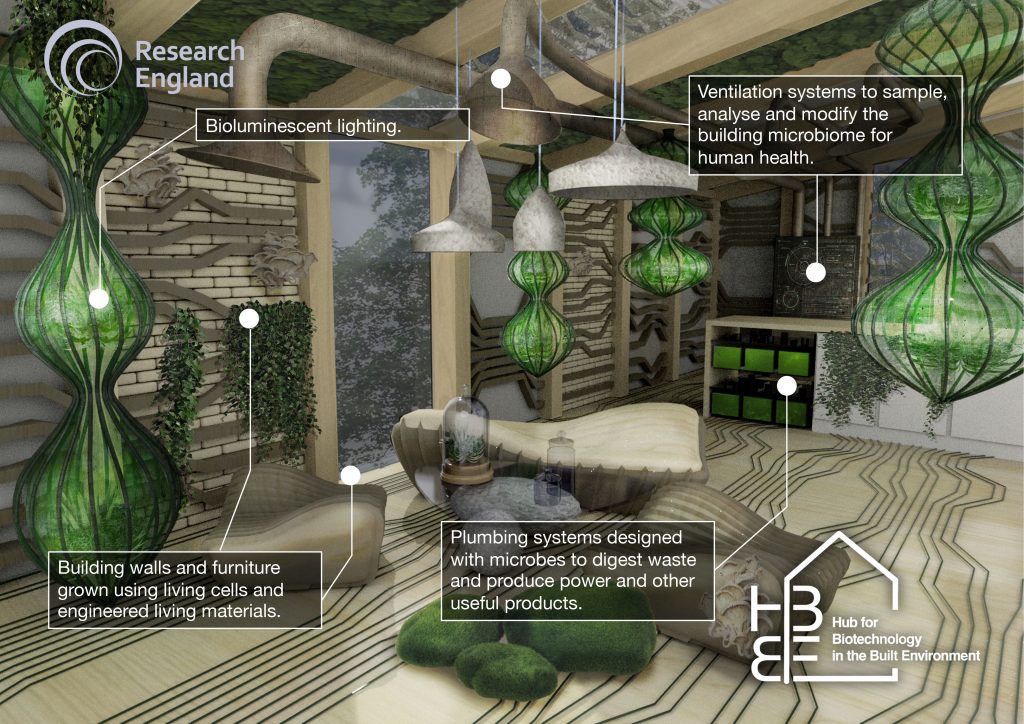Experts from Northumbria and Newcastle Universities will develop new technologies to revolutionise how buildings are constructed and how they operate
The universities have been jointly awarded £8m from Research England’s Expanding Excellence in England (E3) Fund, made available through the modern Industrial Strategy, to establish the world’s first research Hub for Biotechnology in the Built Environment (HBBE).
The investment comes as part of the E3 Fund supporting England’s world-leading universities to shape new innovations in our economy and provide the expertise needed for the highly skilled jobs of the future. The funding will enable the HBBE to lead a reinvention of the way we design and construct our buildings.
The aim of the research hub is to facilitate the creation of a new generation of “Living Buildings”, which are responsive to the natural environment, grown using living engineered materials, process their own waste, reduce pollution, generate energy and support a biological environment that benefits health.
Hub co-director Martyn Dade-Robertson, a professor in emerging technology in the School of Architecture, Planning and Landscape at Newcastle University, said: “This is an incredibly exciting opportunity to create a new field of research. By bringing together architects, engineers and bio-scientists, working with industry and investing in state-of-the-art facilities, we are aiming to rethink the building industry.”
 Research conducted through the HBBE is categorised by three themes. The first is Building Metabolism, which aims to develop a new generation of microbial technologies that will act as building metabolisms – processing waste and generating energy and useful products.
Research conducted through the HBBE is categorised by three themes. The first is Building Metabolism, which aims to develop a new generation of microbial technologies that will act as building metabolisms – processing waste and generating energy and useful products.
The second theme is Living Construction, which will foster a new generation of bulk-engineered living materials that are intelligently synthesised and activated using microbial processes.
The final strand of the research covers Microbial Environments, where the objective is to better understand and computationally predict the interaction between the built environment and microbes and to cultivate healthy environments.
The HBBE will grow by employing a transdisciplinary group of academics, including biologists, designers, engineers, computer scientists, and social scientists associated with each of these three themes.
Strategic investments will be made in three key facilities associated with the development and scaling up of the technologies: These include a Micro-Design Lab, an enhanced microbiology lab based at Northumbria University, which will provide the space and equipment that will drive responsible innovation in microbial molecular biology.
Cutting-edge equipment will be added to Northumbria’s facilities in the Micro-Design Lab to drive Omics studies – the collective technologies used to explore the roles, relationships and actions of the various types of molecules that make up the cells of an organism.
Additionally, a Macro Bio-Design Lab will be established at Newcastle University that will allow engineering, architecture and biology to meet to forge the building blocks of living homes.
Within the Macro Bio-Design Lab will be a workshop that will be used to test the materials and building components. The aim is to develop new approaches and technologies, from molecules right the way up to buildings, which will allow the team to monitor and scale-up biological systems to enable the formation of these biologically inspired Living Buildings.
To create real-life examples of integrating biotechnology into homes, the academics will build an experimental biological house – or living lab – The OME, which will be built on Newcastle University’s campus as part of the project.
The OME will showcase the hub’s groundbreaking research and integration of these biologically driven technologies that limit the impact on their direct environment and also offer health benefits for their inhabitants.
Hub co-director Gary Black, a professor in protein biochemistry at Northumbria University, explains: “We want to use the very latest biotechnologies to build living homes that are responsive to, and protective of, their environment and the people who live in them. The current construction of buildings is unsustainable due to its carbon footprint; the hope would be to use this model in housing in the future.”
The hub will launch with more than 20 members of staff led by a multidisciplinary team across both universities: Professor Martyn Dade-Robertson, Dr Ben Bridgens and Professor Rachel Armstrong of Newcastle University and Professor Gary Black, Dr Meng Zhang and Dr Darren Smith of Northumbria University. The team is one of the 13 research units to receive the first-ever investment from Research England’s Expanding Excellence in England (E3) Fund, launched in 2018, further strengthening Northumbria’s growing reputation for research excellence.
Across the UK, the government is providing the biggest boost to research and development funding in UK history, as part of the ambition to raise the level of R&D funding to 2.4% of GDP by 2027.
Dr Martyn Dade-Robertson
Co-director
Hub for Biotechnology in the Built Environment
Tel: +44 (0)191 208 5926
martyn.dade-robertson@ncl.ac.uk
http://bbe.ac.uk/index.php/dr-martyn-dade-robertson/
Twitter: @martyndr
Professor Gary Black
Co-director
Hub for Biotechnology in the Built Environment
http://bbe.ac.uk/index.php/prof-gary-black/
Twitter: @bio_buildings
















